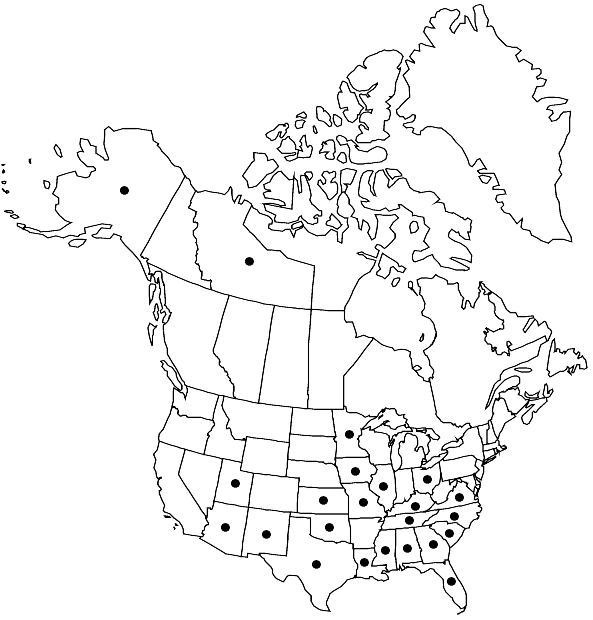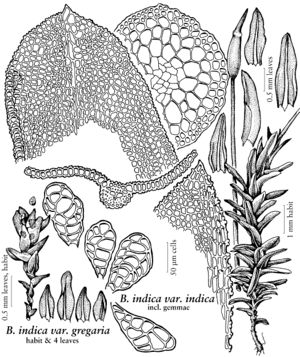Difference between revisions of "Barbula indica var. indica"
FNA>Volume Importer |
imported>Volume Importer |
||
| (3 intermediate revisions by 2 users not shown) | |||
| Line 1: | Line 1: | ||
{{Treatment/ID | {{Treatment/ID | ||
|accepted_name=Barbula indica var. indica | |accepted_name=Barbula indica var. indica | ||
| − | |accepted_authority= | + | |accepted_authority= |
|publications= | |publications= | ||
|basionyms= | |basionyms= | ||
| Line 7: | Line 7: | ||
|name=Barbula cancellata | |name=Barbula cancellata | ||
|authority=Müller Hal. | |authority=Müller Hal. | ||
| + | |rank=species | ||
}} {{Treatment/ID/Synonym | }} {{Treatment/ID/Synonym | ||
|name=Barbula cruegeri | |name=Barbula cruegeri | ||
|authority=Müller Hal. | |authority=Müller Hal. | ||
| + | |rank=species | ||
}} | }} | ||
|hierarchy=Pottiaceae;Pottiaceae subfam. Barbuloideae;Barbula;Barbula indica;Barbula indica var. indica | |hierarchy=Pottiaceae;Pottiaceae subfam. Barbuloideae;Barbula;Barbula indica;Barbula indica var. indica | ||
| Line 24: | Line 26: | ||
|elevation=low to moderate elevations (50-1000 m) | |elevation=low to moderate elevations (50-1000 m) | ||
|distribution=N.W.T.;Ala.;Alaska;Ariz.;Fla.;Ga.;Ill.;Iowa;Kans.;Ky.;La.;Minn.;Miss.;Mo.;N.Mex.;N.C.;Ohio;Okla.;S.C.;Tenn.;Tex.;Utah;Va.;Mexico;West Indies;Central America;South America;Europe (Hungary);Asia;Africa;Pacific Islands (Hawaii);Australia. | |distribution=N.W.T.;Ala.;Alaska;Ariz.;Fla.;Ga.;Ill.;Iowa;Kans.;Ky.;La.;Minn.;Miss.;Mo.;N.Mex.;N.C.;Ohio;Okla.;S.C.;Tenn.;Tex.;Utah;Va.;Mexico;West Indies;Central America;South America;Europe (Hungary);Asia;Africa;Pacific Islands (Hawaii);Australia. | ||
| − | |discussion=<p>Capsules of < | + | |discussion=<p>Capsules of <i></i>var.<i> indica</i> are rare in the flora area but mature in summer in Mexico. The gemmae are usually small and obovoid, but in some specimens are somewhat enlarged and branching. The typical variety is commonly fruiting; the seta is reddish, unlike that of <i>Barbula convoluta</i>, which is yellow. This species is often misidentified as <i>B. unguiculata</i> in the southeastern states, but viewed from the side, the abaxial costal papillae form rows across the costa, lined up as they are at both ends of epidermal cells. A hygrophylic variant may be confused with <i>B. bolleana</i> when incrusted with lime but its leaf cells are much smaller. The Alaskan station is clearly of this variety, though the prorulae are poorly developed, being replaced with dense simple to 2-fid papillae; the Northwest Territories specimen is more clearly of the standard morphotype.</p> |
|tables= | |tables= | ||
|references= | |references= | ||
| Line 33: | Line 35: | ||
-->{{#Taxon: | -->{{#Taxon: | ||
name=Barbula indica var. indica | name=Barbula indica var. indica | ||
| − | + | |authority= | |
| − | |authority= | ||
|rank=variety | |rank=variety | ||
|parent rank=species | |parent rank=species | ||
| Line 47: | Line 48: | ||
|publication year= | |publication year= | ||
|special status= | |special status= | ||
| − | |source xml=https:// | + | |source xml=https://bitbucket.org/aafc-mbb/fna-data-curation/src/2e0870ddd59836b60bcf96646a41e87ea5a5943a/coarse_grained_fna_xml/V27/V27_766.xml |
|subfamily=Pottiaceae subfam. Barbuloideae | |subfamily=Pottiaceae subfam. Barbuloideae | ||
|genus=Barbula | |genus=Barbula | ||
Latest revision as of 21:28, 5 November 2020
Leaves narrowly oval to elliptic, margins plane or weakly recurved at mid leaf. Specialized asexual reproduction by small, green, obovoid gemmae occurring in masses in distal leaf axils, of several cells, 70–90 µm.
Habitat: Soil, clay, limestone, cement, walls
Elevation: low to moderate elevations (50-1000 m)
Distribution

N.W.T., Ala., Alaska, Ariz., Fla., Ga., Ill., Iowa, Kans., Ky., La., Minn., Miss., Mo., N.Mex., N.C., Ohio, Okla., S.C., Tenn., Tex., Utah, Va., Mexico, West Indies, Central America, South America, Europe (Hungary), Asia, Africa, Pacific Islands (Hawaii), Australia.
Discussion
Capsules of var. indica are rare in the flora area but mature in summer in Mexico. The gemmae are usually small and obovoid, but in some specimens are somewhat enlarged and branching. The typical variety is commonly fruiting; the seta is reddish, unlike that of Barbula convoluta, which is yellow. This species is often misidentified as B. unguiculata in the southeastern states, but viewed from the side, the abaxial costal papillae form rows across the costa, lined up as they are at both ends of epidermal cells. A hygrophylic variant may be confused with B. bolleana when incrusted with lime but its leaf cells are much smaller. The Alaskan station is clearly of this variety, though the prorulae are poorly developed, being replaced with dense simple to 2-fid papillae; the Northwest Territories specimen is more clearly of the standard morphotype.
Selected References
None.
